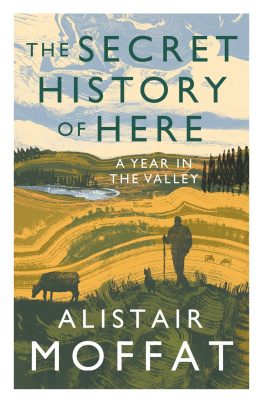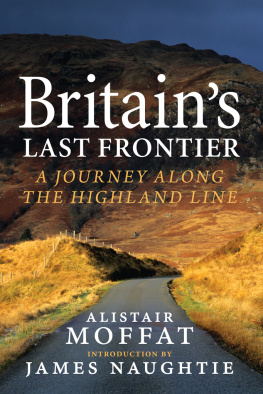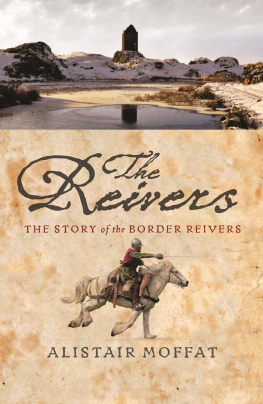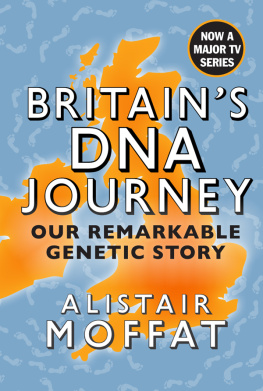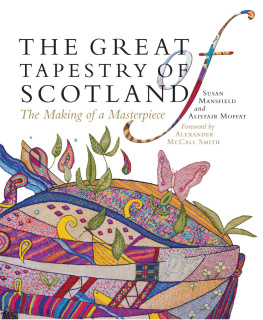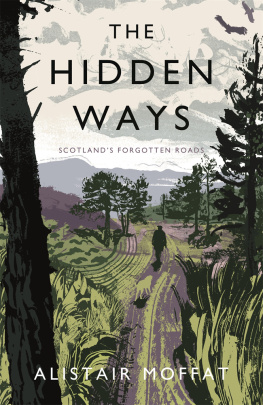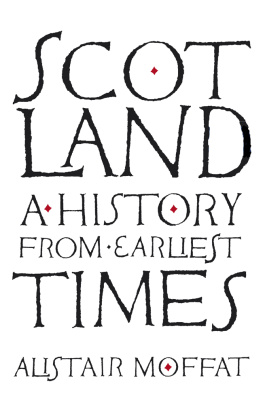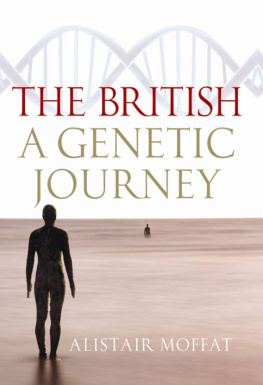
Alistair Moffat was born in Kelso, Scotland in 1950. He is an award-winning writer, historian and Director of Programmes at Scottish Television, former Director of the Edinburgh Festival Fringe, and former Rector of the University of St Andrews. He is the founder of Borders Book Festival and Co-Chairman of The Great Tapestry of Scotland, and the author of The Hidden Ways: Scotlands Forgotten Roads and To the Island of Tides: A Journey to Lindisfarne.
alistairmoffat.co.uk
Also by Alistair Moffat
The Sea Kingdoms: The History of Celtic Britain and Ireland
The Borders: A History of the Borders from Earliest Times
Before Scotland: The Story of Scotland Before History
Tyneside: A History of Newcastle and Gateshead from Earliest Times
The Reivers: The Story of the Border Reivers
The Wall: Romes Greatest Frontier
Tuscany: A History
The Highland Clans
The Faded Map: The Lost Kingdoms of Scotland
The Scots: A Genetic Journey
Britains Last Frontier: A Journey Along the Highland Line
The British: A Genetic Journey
Hawick: A History from Earliest Times
Bannockburn: The Battle for a Nation
Scotland: A History from Earliest Times
The Hidden Ways: Scotlands Forgotten Roads
To the Island of Tides: A Journey to Lindisfarne

For Walter Elliot and Rory Low
The paperback edition published in Great Britain in 2022 by Canongate Books
First published in Great Britain, the USA and Canada in 2021
by Canongate Books Ltd, 14 High Street, Edinburgh EH1 1TE
Distributed in the USA by Publishers Group West and in
Canada by Publishers Group Canada
canongate.co.uk
This digital edition first published in 2021 by Canongate Books
Copyright Alistair Moffat, 2021
Illustrations and map Andrew Crummy, 2021
The right of Alistair Moffat to be identified as the author of this work has been asserted by him in accordance with the Copyright, Designs and Patents Act 1988
British Library Cataloguing-in-Publication Data
A catalogue record for this book is available on
request from the British Library
ISBN 978 1 83885 114 9
eISBN 978 1 83885 115 6
Contents

Foreword
Once Upon a Time
The Long Track lies fast asleep. The dawn track, it waits under the blanket of the night for the grey of the eastern sky to glow pink. Nothing stirs. Birds roost in the trees and the animals of the woods hide snug in their burrows, invisible to the blinking stare of the owls, perched still on the upper branches, watching, waiting for movement. The sleeping voles, rabbits and mice curl up in their own body warmth, safe from the snuffling of night predators nosing through the leaves of long-dead summers.
High above the Long Track the silence shudders with the wing-beats of two swans, their heads and necks spear-straight as they wheel south towards the waters of the great river. Under the shadows of the trees the night slumbers on.
Over the heads of the woods to the east the black horizon of the hills waits for the light to rise. In the half-world before dawn, the ghost hours, a sudden mist falls, shrouding the track and the trees. Far in the distance, roosting crows lift into the air, their cawing, cackling racket echoing around the valley. Then there is a snort, a whinny and out of the mist rides an armoured knight. Neck-reining his mighty destrier, he slows the stallion to a walk and soothing words murmur across the fields. Ramrod-straight in the saddle, his helm slung over the pommel, his armour a dull lustre in the morning light, the knight stares fixedly ahead. When a breeze suddenly riffles through the trees, the long caparison on his destrier billows, a blood-red crusader cross on white silk.
Behind rides an esquire on a little palfrey, his pennant planted in a stirrup niche, his liveried tabard bright with the device of his lord. Swivelling in the saddle, he turns to look for those who follow, listening for the creaks of the carts and the rumble of their wheels on the stones of the Long Track. The plod of the destrier and the palfrey linger as the knight and his esquire disappear into the morning mist.
On the edges of the wood, the children of the mist are playing. Visible only when they move, deer graze in the clearings. While the little fawns race each other, coming to sudden stops, making impossible turns, the does look up, ears pricked, searching for threat. In deep cover, it is waiting. Downwind, by the trickle of the burn at the foot of the track, two hunters hide in the tangle of undergrowth, silently grimacing at the prick of briars and thorns, camouflaged in their buckskin tunics. Moving very slowly, they inch their way closer to the grazing deer. They know they will have only one shot before their prey scatter, skittering back into the wood in a moment. The wind suddenly shifts, the does look up, their ears flicking, searching for the small sounds of danger, ready to run. The hunters nock their flint-tipped arrows, stand up, let fly, and a fawn staggers and stumbles. Pierced in the flank, the young animal bays in shock and pain, gets up and runs unsteadily. Even though the fawn gains the cover of the trees, the hunters will follow the blood trail and make their kill when the wounded animal is too weak to run beyond the range of their arrows.
Over the eastern ridges the sun climbs and the mist fades in moments. A tide of butter-coloured light washes down the valley, and on the Long Track the jingle of harness is heard. Wrapped in their cloaks against the morning chill, two riders trot up to the northern ridge. Without shields or spears, these scouts carry only the spatha, the cavalry sword. In hostile country, their eyes and ears are better weapons. Down in the valley, on the southern side of the burn, the ranks of a vast army march in battle order, theirnailed boots thudding, standards glinting red and gold in the morning sun. Trumpeters send signals: halt, stand easy, form line, close ranks, march on. Brigaded together into an invasion force, the legions of Gnaeus Julius Agricola, governor of the province of Britannia, have been sent into the territory of the Selgovae, a native kindred. Leading each detachment are the eagles of the XX Valeria Victrix, the IX Hispana and the II Augusta. They begin to climb into the western hills until their surveyors call a halt and mark out the perimeter of a camp. As a screen of sentries scan the hills for movement, ditches are quickly dug and at the gates a wooden tower raised. Far to the east, soldiers can see the flash of shiny metal from the signal station above the great army depot by the River Tweed. Wrapping the landscape in a web of roads, Rome tightens its grip. Hidden in the Wildwood, native warriors watch and wait.
The shadow of war was not often cast over the Long Track. Few heard the clangour of distant battles. The march of history across the landscape usually happened elsewhere. Mostly the track was walked and ridden by peaceful travellers going about their business, or people seeking pleasure, perhaps solace. Bands of pilgrims bound for the shrines at Melrose or Jedburgh sang psalms, the burgesses of the royal burgh of Selkirk beat the bounds of their precious common land, wealthy estate owners planted an avenue of trees on either side of the track and made good the ruts and puddles so that their ladies could enjoy carriage drives, their umbrellas shading the afternoon sun. But war did change the track. In 1940, hardwood was needed and sawyers came to cut the mighty trees. Long gone by then, the Wildwood was planted with rows of sitka spruce after 1945.

